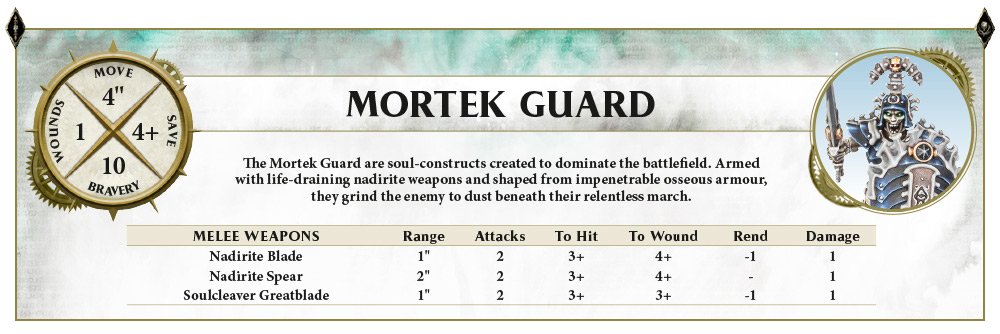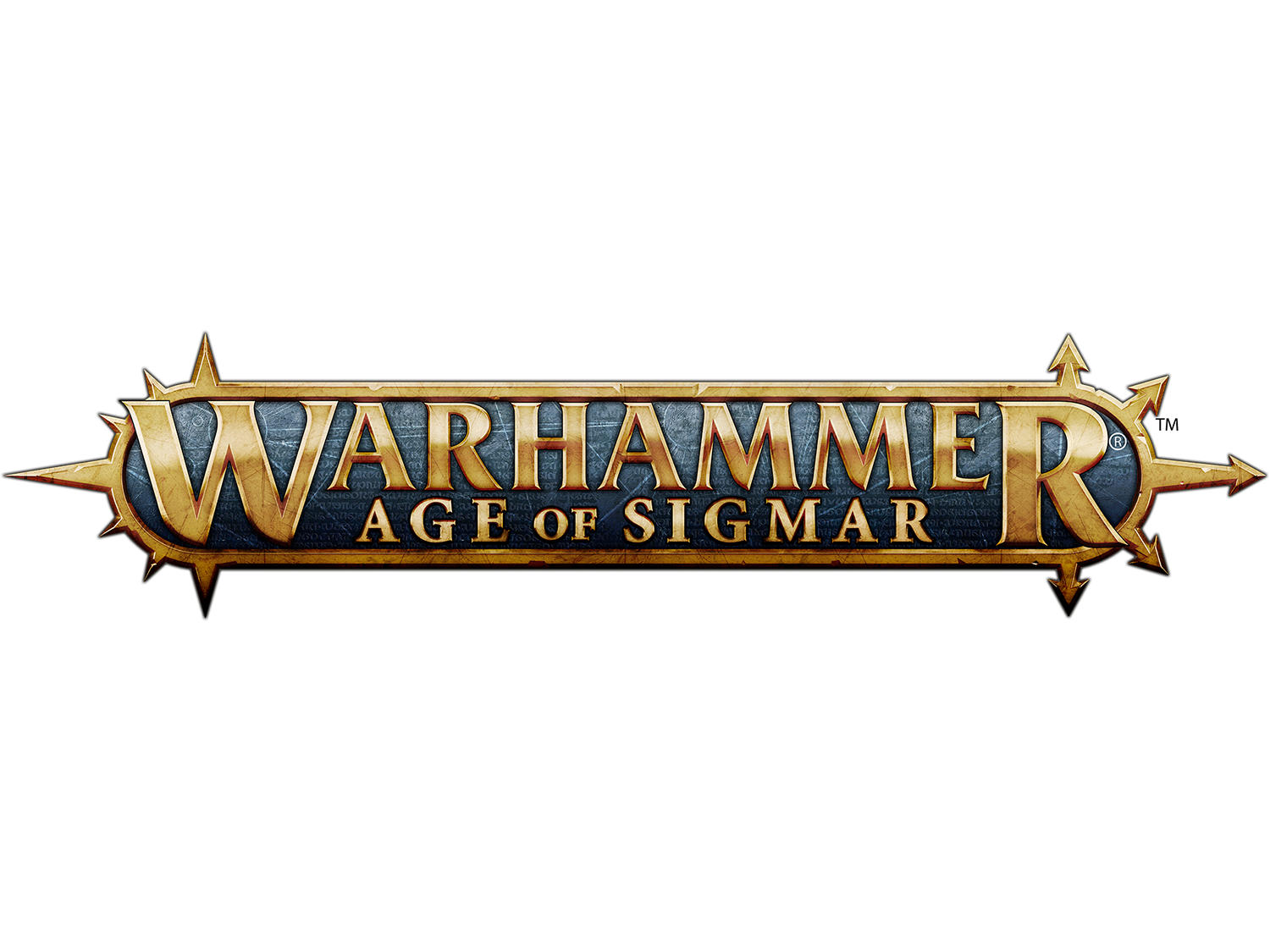Warhammer Age of Sigmar
Overview
Warhammer: Age of Sigmar is a tabletop miniatures war game for two players. For those familiar with Warhammer, go ahead and skip to the Review header. Everyone else read on for a deeper look into not only the game but the hobby of Warhammer!
As stated above, Warhammer is a tabletop game, including lots of tactical decision-making, like where and how to move your units of soldiers, which enemies to attack first, etc. But well before getting models to the table, they’ll need to be assembled, and, if one is so inclined, painted!
Models come on what are known as sprues, and they contain all the bits you need to build a single unit of models. They’re usually divided into torsos, legs, heads, and frequently an assortment of arms holding different weapons or in different poses. Since units usually have different options in terms of which weapons they might want to bring to the battle, you’ll either need to decide which weapons to wield at this stage or, if you’re the “serious” type of hobbyist, glue magnets onto the joints so you can swap them between battles!
After assembly, painting is optional. Certainly not necessary to begin enjoying the game, though I will say two painted armies battling it out on a tabletop is a sight to behold!
Warhammer has two primary lines of models: Warhammer 40,000, their grimdark futuristic setting, and Age of Sigmar (AoS), their similarly grimdark fantasy setting. While both are entertaining in their own right, I am going to focus on Age of Sigmar for this review.
AoS battles are waged between two opposing forces, and there are a whopping twenty-four different factions to choose from, and even more options within each of those. They’re all split into four overarching “Alliances,” including:
Order (Humans, Elves, Dwarves, etc.)
Chaos (Beastmen, Daemons, Rats, etc.)
Death (Ghosts, Skeletons, Vampires, etc.)
Destruction (Ogres, Orcs, Trolls, etc.).
Granted, Games Workshop uses names they can copyright for their armies, so you’d have to look at their “Ogors” versus “Ogres,” or “Orruks” instead of “Orcs,” but you get the idea.
Gameplay
Once all relevant models have been gathered up, army lists are mustered, and a suitable table (usually 6’ by 4’) has been established and terrain placed like the one shown below, players will agree on a “Mission.” Missions explain the objective of the game, which frequently revolve around “Objective Points” which represent either objects or locations of particular importance or value. Gone are the days of slugging it out until one army is left standing! Missions vary widely, and offer a ton of fun experiences. Missions will also outline the boundaries of each players’ starting army where they will deploy their units.
Once setup is complete, it is time to get to the action! Individual player turns consist of a few phases, and this is where a player can cast spells, offensive, defensive, and outright strange, shoot volleys of arrows and lead, and charge into combat to strike opponents down with sword and spear.
AoS is a game of dice rolling. For all your strategizing, planning, and maneuvering, it’ll all be for nought if you can’t hit your rolls! Players roll d6s (six-sided dice) to determine successful spell casting, movement distance when charging, and, perhaps most importantly, inflicting damage on opposing models. Many of the special rules in the game help to mitigate these rolls, offering rerolls, +1 to certain attacks, rolling additional dice, etc. so you aren’t *completely* at the mercy of random swings. The number of dice you need for each attack, as well as the numbers you need for success can be found on each units’ “warscroll.” We can take a look at the basic skeleton warrior unit “Mortek Guard” as an example:

This tells me that each skeleton within range of an enemy can roll two dice, with rolls of three or better succeeding in hitting my opponents’ models. If I attack with a unit of ten skeletons, then I will roll twenty dice, all of which need a three, four, five, or six to hit. Once I have determined the number of successes, I will roll those dice again in order to determine how many of those hits actually wound my opponent, this time looking for four, five, or six.
After that, my opponent has a chance to defend or shrug off the wounds with their Save characteristic, rolling a die for each success and comparing the results with their stats. Any unsaved results will inflict wounds based on the damage characteristic, which in the case of the swords is a single damage. While that doesn’t sound like a lot, those numbers grow with larger blobs of skeletons, and the math gets more intimidating when you take all the special rules into account.
At the end of the day, as highlighted above, modern games of AoS are far more about positioning than about dealing the most damage. If I control more objective points than my opponent, it doesn’t really matter how much damage I am dealing each turn. Choosing to tie up opposing units with a drawn out slugfest over the course of multiple turns while other units secure objective points might well be the best decision, even if it is only a matter of time until all my skeletons eventually die.
Review
Beyond the minutiae of math behind the game, AoS is a game about tactics and making difficult but rewarding decisions every turn. It can be a game of big, dynamic turns that change the course of the game every round, or a cold, slow march up the board eating up every unit you encounter. Twenty-four armies, each with dozens upon dozens of list-building options and army formations, means no two games of Warhammer Age of Sigmar will be the same. Because the game uses tape measures instead of squares or hexes, you are truly only limited in how you play by your imagination. Conga-line your lizard dudes across the board, or bunch up your steampunk dwarves into an impenetrable phalanx. Fly your ghost cavalry up the field for an early flank, or hunker down your immortal archers on a hilltop to rain down fury from the skies!
A lot of what I love about Age of Sigmar takes place in the Command Phase, which is the first thing you’ll do on your turn before moving or attacking. This phase allows you to activate powerful abilities to buff up your army or disrupt your opponent, and where you’ll get to cast all the amazing spells you can find in your army’s warscrolls. Much of pre-game strategizing revolves around identifying synergies between the Heroes you field and the units that complement their play style. Some Heroes want to be in the midst of the fray, leading from the front and activating powerful Aura abilities, lending their legendary strength to nearby units to stomp out opponents. Other, generally more frail Heroes, might hide behind a unit of elite bodyguards, casting predatory spells or terraforming the battlefield to fit your needs moment-to-moment.
Ultimately, this is a big, long, intimidating game, especially at the large, common 2000-point games. That alone is enough to scare off a lot of would-be gamers. It is one of the more difficult aspects of the game to overcome for a lot of newer hobbyists. It is why, frankly, I stopped playing for a long time myself. For all the fun you can have playing this game, which is A LOT, it is also a lot to invest in on the front end, both in terms of money and time. Luckily, Gamescape’s community has decided to host a Path to Glory campaign beginning in February! This is a format of the game that starts with only a handful of units with a small group of beginners and slowly grows the game at a comfortable pace, sometimes reaching 200 points by the end, sometimes keeping things on the smaller end of things for the full experience.
If you’re at all interested in checking out Age of Sigmar, come on in and take a look at the incredibly cool models on the shelf and see if any of them strike your fancy. We can get you started at a reasonable entry point, and help you out with the building and painting aspects with our incredibly talented and passionate community members! We have a great group of players and hobbyists, so come spill some paint and roll some dice and just have fun with it. At the end of the day, that is what it is all about!
Warhammer Age of Sigmar products are available now from our webstore.
